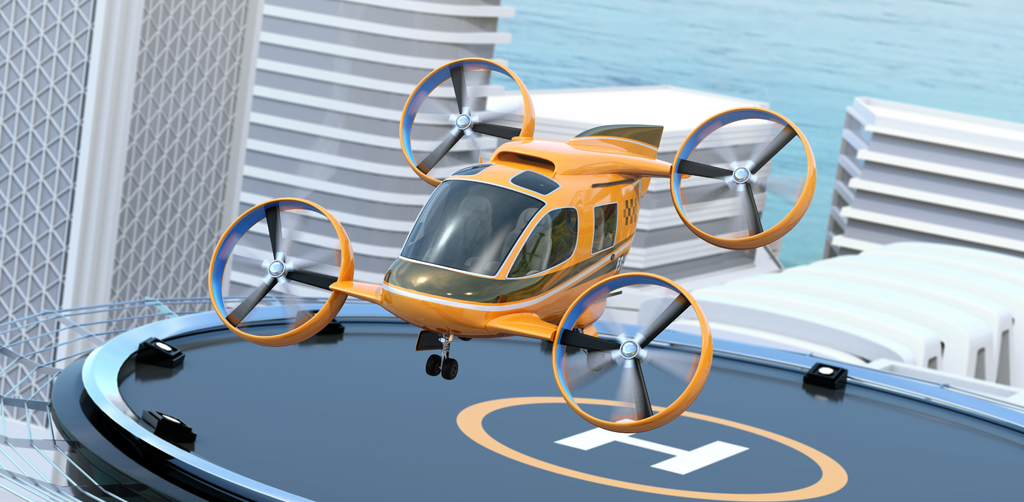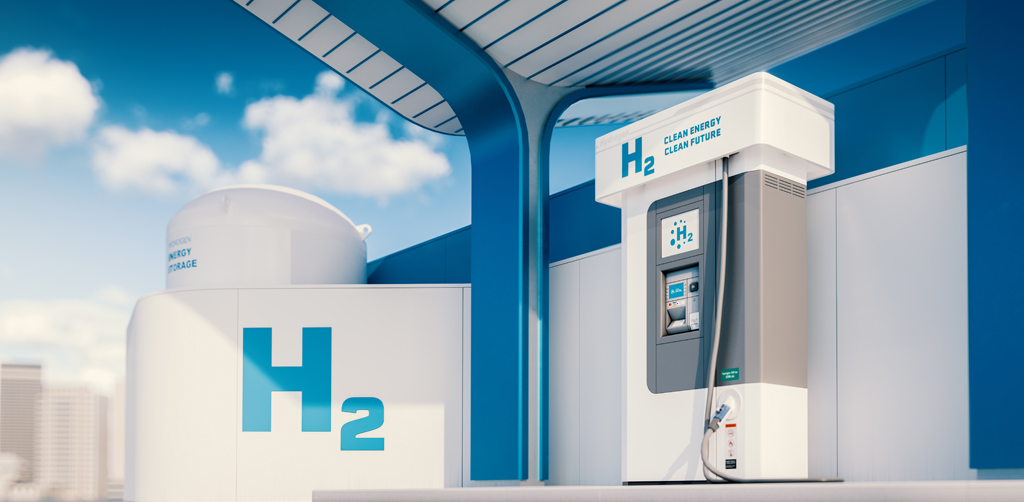Five Areas Composites Will Impact in 2022 and Beyond

As new industry segments emerge and existing industry segments look for higher levels of efficiency, they are being driven to composite components as effective solutions to problems such as corrosion, weight reduction, fuel efficiency and miniaturization of components. Traditionally, these parts have been made from thermoset composites. As these parts get smaller and more complex, this drives the need for a different type of composite solution, and thermoplastic composites are being used. Parts made from thermoplastic composites can be designed with more complexity and can scale up manufacturing for higher volume parts.
Innovations in composites, spurred by the Aerospace industry are now starting to find traction in other industries and applications. We will look at five industry segments that will be impacted or enabled by thermoplastic composite technology in 2022 and beyond.
Urban Air Mobility (UAM)

The Aerospace industry has been leading the way with composite material innovation. Composite materials continue to displace metal on new aerospace platforms due to recognized performance, life cycle, and manufacturing advantages, with the Airbus A350 and Boeing 787 as two commercial aircraft examples demonstrating over 50% composite content [1, 2]. Composites are commonly used for large primary and secondary structure applications based on cost-effective benefits from weight reduction, design freedom, and service life. Some of the common examples are aircraft wings, wind turbine blades, or automotive chassis. These parts are traditionally made from thermoset composites.
The challenge of modern traffic congestion and typical commute in the metropolitan areas around the world has been getting worse over the last couple of decades. Instead of thinking in two dimensions, the pioneers at UAM manufacturers are thinking in three dimensions to take some of the pressure off metropolitan roadways.
It's no simple task to take aerospace technology in today’s most modern commercial passenger aircraft and bring it into a small-scale package for the urban environment. Weight, noise, safety, and performance are all serious considerations. Modern aircraft have been utilizing thermoset composite structures for many years. The UAM manufacturers are embracing traditional thermoset composites into their designs, while adopting newer thermoplastic composites at the same time.
The typical applications for thermosets composites are large components, but the smaller interconnection components are still designed for metal. The complexity and volume of the metal components make them difficult applications to transition from metal to traditional thermoset composites. This is where thermoplastic composites can bring light-weighting and strength as well as the ability to make complex shapes. Companies with thermoplastic composites platforms like Greene Tweed’s Xycomp® DLF have been meeting that challenge in Aerospace and will continue to change the perception of complex shape metal replacement in the UAM market segment with our aerospace qualified thermoplastic composite products.
Space Applications

There have been many firsts for the space industry in the last 10 years, most notably “SpaceX’s Falcon 9 rocket first stage successfully returning to Earth near its launch site” [3]. Breakthroughs like reusable rocket stages have been pioneered by commercial space companies and are driving the space industry to new heights. Reusable rockets have drastically lowered the cost of launching spacecraft into LEO (Low Earth Orbit), and this has begun to enable the business case for satellite constellations on a scale we have never seen. Satellites and satellite constellations (larger groups of satellites working together as a system) are nothing new, but the scale and volume of these new constellations dwarf anything done in the past. The advent of ride-sharing (splitting up the rocket’s cargo area into separate purchasable sections for multiple companies to share one rocket) has opened the industry for smaller organizations and universities to be able to launch their own satellite(s) into orbit. As recently as January 2021, SpaceX’s “The Falcon 9 rocket carried 143 spacecraft into orbit, which is a new global record for the most spacecraft launched at once” [4].
These satellites are using advanced materials like composites to reduce weight at launch and help extend the service life of these spacecraft. Composites bring unique values like reducing weight to enable additional satellites in a rocket’s payload, parts consolidation for reduced assembly time and uniform CTE (coefficient of thermal expansion), and the ability to mold in features that can enable new configurations to be achieved in the same or smaller sizes. Several different components on satellites can benefit from using composites such as solar arrays, antennas, spacecraft/payload structure, power systems, propulsion systems, and others.
What will be space explorations firsts in the next ten years? Could it include the first commercial space tourism flights, the first commercial space station, and/or the first man on Mars? Only time will tell, but it's very likely that thermoplastic composites will be along for the ride.
Robotics

Robotic technology has impacted many industries and applications, including aerospace, defense, industrial manufacturing, oil & gas, medical, and other industries. These robotic technology applications can include co-bots working side by side with their human co-workers, human-controlled robots going into extreme conditions (so humans don’t have to), and unmanned vehicles doing work that was previously not able to be done by a human. Robotics is a truly revolutionary technology that has the potential to affect all walks of life in all industries.
As a result of robots growing presence, for certain applications, robot weight, payload weight, battery life, and safety become critical design features. This is where high-performance thermoplastic composites can bring value. Typically, the size and complexity of these robots don’t lend themselves to traditional thermoset composites, especially considering the volumes required.
Complex shape metal replacement with a compression molded thermoplastic can help drastically reduce the weight of the robot helping it transport heavier payloads and/or have an extended battery life. These benefits can help with operational efficiency and sometimes be the factor that makes robotics possible (in a specific application). Greene Tweeds Xycomp® DLF (Discontinuous Long Fiber) thermoplastic composite solutions can bring weight reduction, parts consolidation, mold in features, and more when replacing complex shape metal parts.
Hydrogen Economy

The new hydrogen economy has the potential to disrupt and change the energy world, but the only way the hydrogen economy makes sense is if it is based on green hydrogen. The rise of renewable energy, the push for net-zero economies by governments and the private sector, and the potential for green hydrogen all play a part in the emergence of a hydrogen economy. Current applications for hydrogen are rocket fuel, industrial processes, and chemical manufacturing, but the future of hydrogen’s real potential is as a clean source of fuel for transportation and power generation. Processing hydrogen possess its own challenges beyond just changing the infrastructure.
One of the largest challenges in the infrastructure change will be moving the hydrogen from production to points of use. Hydrogen is a small molecule gas, and traditional centrifugal compressors are unable to transport pure hydrogen due to issues with metal embrittlement and lower pressure ratio that requires an increase of rotational speed impossible to reach with traditional metallic impellers due to tip speed limitations.
The development of an entire new hydrogen supply chain from green hydrogen production to hydrogen energy storage and fuel cell electric vehicles will increase the need for the next generation centrifugal compressors that can handle high purity hydrogen efficiently. These new centrifugal compressors will be enabled by high-performance thermoplastic composite solutions.
Thermoplastic composite labyrinth seals can improve the efficiency of centrifugal compressors by 1% or more, while not falling victim to corrosion or metal embrittlement. Impellers made from high strength-to-weight ratio thermoplastic composites have the potential to enable centrifugal compressors to process high purity hydrogen, by reducing impeller weight and stress on the rotor, thus allowing higher rotational speeds. These technologies will enable OEMs to provide the necessary equipment for energy companies and governments to realize the benefits of green hydrogen as an effective energy alternative to fossil fuels.
Semiconductor manufacturing

The semiconductor industry has seen an incredible amount of demand and supply pressure during the pandemic with the emergence of the work from home economy and supply chain challenges due to COVID-19. There are many steps in the manufacturing of IC chips including etch, lithography, deposition, wafer cleaning and others. These steps use exotic and harsh chemistries to create complex node structures that enable today’s level of computing power.
The challenges associated with controlling particulate and chemical contamination to achieve high semiconductor device yields as pattern feature sizes shrink have become increasingly difficult to solve. Parts used in chambers and cleaning processes must be able to withstand higher temperatures and harsh chemical environments without degrading or creating particulates. These conditions lead to replacing existing materials with advanced thermoplastic composite materials and new manufacturing methods to meet the temperature and chemical resistant requirements for the next generation of wafer processing equipment.
References:
[1] “Boeing 787 Design Highlights”, www.boeing.com, accessed 22 April 2015, http://www.boeing.com/ commercial/787/#/design-highlights/visionary-design/composites/advanced-composite-use/.
[2] Keith Campbell. “Airbus to start manufacturing parts for new A350 XWB in late ‘09”, Engineering News online, 11 May 2009, http://www.engineeringnews.co.za/article/airbus-to-start-manufacturing-parts-fornew-a350-xwb-in-late-09-2009-05-11.
[3] “SpaceX” , britanica.com, accessed October 2021, https://www.britannica.com/topic/SpaceX.
[4] Michael Sheetz. “SpaceX launches a ‘rideshare’ mission carrying 143 spacecraft, a record for a single launch”, CNBC, 24 January 2021, https://www.cnbc.com/2021/01/24/spacex-launches-rideshare-mission-with-143-spacecraft.html.